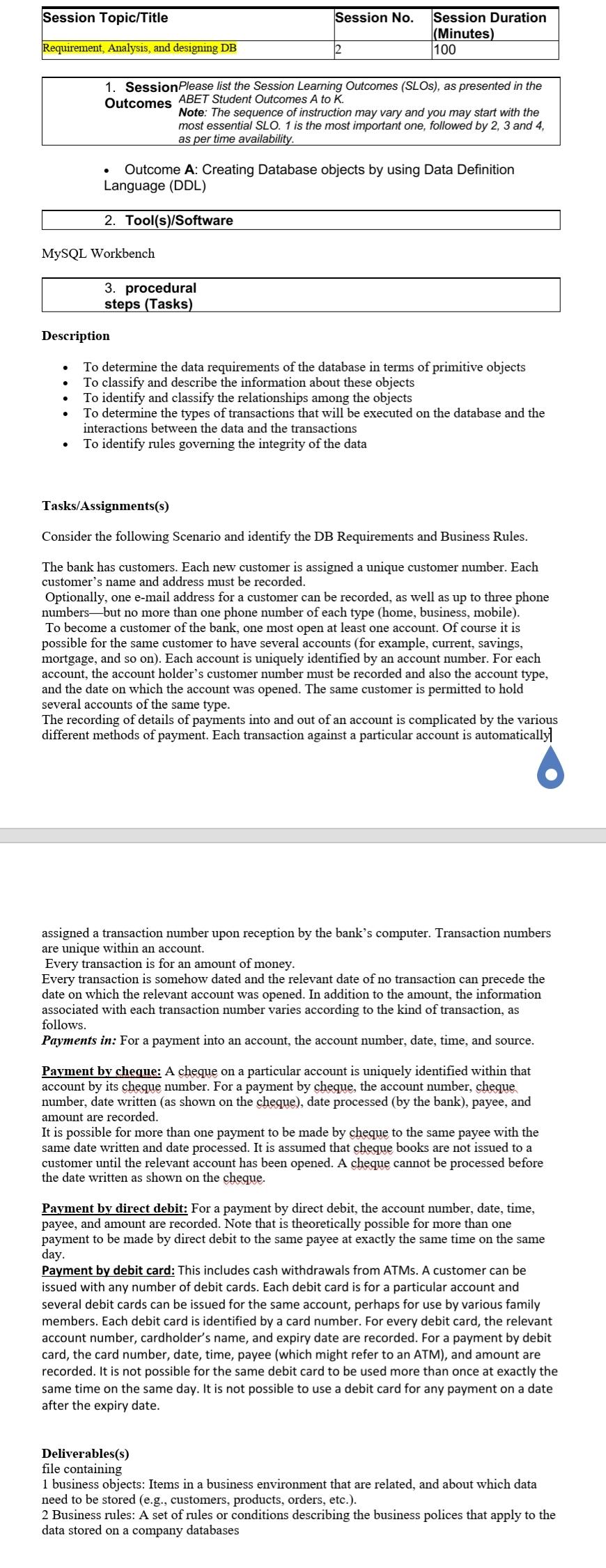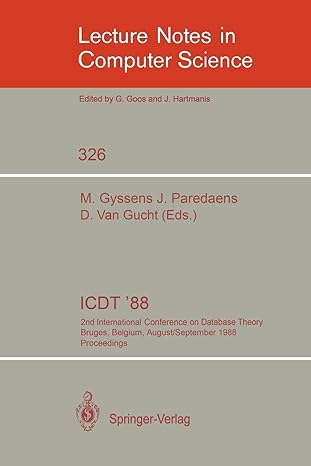Answered step by step
Verified Expert Solution
Question
1 Approved Answer
please what the answer for lab database?? Requirement, Analysis, and designing DB 1. Session Please list the Session Learning Outcomes (SLOs), as presented in the
 please what the answer for lab database??
please what the answer for lab database??
Requirement, Analysis, and designing DB
1. Session Please list the Session Learning Outcomes (SLOs), as presented in the Outcomes ABET Student Outcomes A to K. Note: The sequence of instruction may vary and you may start with the most essential SLO. 1 is the most important one, followed by 2,3 and 4 , as per time availability. - Outcome A: Creating Database objects by using Data Definition Language ( DDL) 2. Tool(s)/Software MySQL Workbench 3. procedural steps (Tasks) Description - To determine the data requirements of the database in terms of primitive objects - To classify and describe the information about these objects - To identify and classify the relationships among the objects - To determine the types of transactions that will be executed on the database and the interactions between the data and the transactions - To identify rules governing the integrity of the data Tasks/Assignments(s) Consider the following Scenario and identify the DB Requirements and Business Rules. The bank has customers. Each new customer is assigned a unique customer number. Each customer's name and address must be recorded. Optionally, one e-mail address for a customer can be recorded, as well as up to three phone numbers - but no more than one phone number of each type (home, business, mobile). To become a customer of the bank, one most open at least one account. Of course it is possible for the same customer to have several accounts (for example, current, savings, mortgage, and so on). Each account is uniquely identified by an account number. For each account, the account holder's customer number must be recorded and also the account type, and the date on which the account was opened. The same customer is permitted to hold several accounts of the same type. The recording of details of payments into and out of an account is complicated by the various different methods of payment. Each transaction against a particular account is automatically] assigned a transaction number upon reception by the bank's computer. Transaction numbers are unique within an account. Every transaction is for an amount of money. Every transaction is somehow dated and the relevant date of no transaction can precede the date on which the relevant account was opened. In addition to the amount, the information associated with each transaction number varies according to the kind of transaction, as follows. Payments in: For a payment into an account, the account number, date, time, and source. Payment by chegue: A cheque on a particular account is uniquely identified within that account by its cheque number. For a payment by cheque, the account number, cheque number, date written (as shown on the cheque), date processed (by the bank), payee, and amount are recorded. It is possible for more than one payment to be made by cheque to the same payee with the same date written and date processed. It is assumed that cheque books are not issued to a customer until the relevant account has been opened. A cheque cannot be processed before the date written as shown on the cheque. Payment by direct debit: For a payment by direct debit, the account number, date, time, payee, and amount are recorded. Note that is theoretically possible for more than one payment to be made by direct debit to the same payee at exactly the same time on the same day. Payment by debit card: This includes cash withdrawals from ATMs. A customer can be issued with any number of debit cards. Each debit card is for a particular account and several debit cards can be issued for the same account, perhaps for use by various family members. Each debit card is identified by a card number. For every debit card, the relevant account number, cardholder's name, and expiry date are recorded. For a payment by debit card, the card number, date, time, payee (which might refer to an ATM), and amount are recorded. It is not possible for the same debit card to be used more than once at exactly the same time on the same day. It is not possible to use a debit card for any payment on a date after the expiry date. Deliverables(s) file containing 1 business objects: Items in a business environment that are related, and about which data need to be stored (e.g., customers, products, orders, etc.). 2 Business rules: A set of rules or conditions describing the business polices that apply to the data stored on a company databasesStep by Step Solution
There are 3 Steps involved in it
Step: 1

Get Instant Access to Expert-Tailored Solutions
See step-by-step solutions with expert insights and AI powered tools for academic success
Step: 2

Step: 3

Ace Your Homework with AI
Get the answers you need in no time with our AI-driven, step-by-step assistance
Get Started


